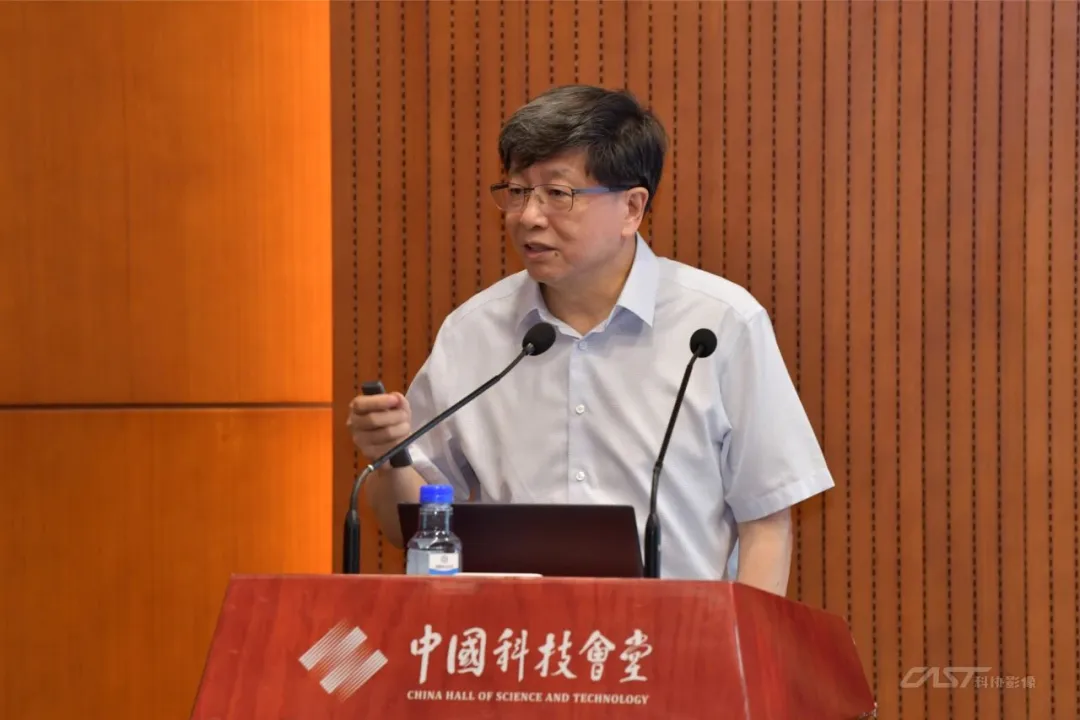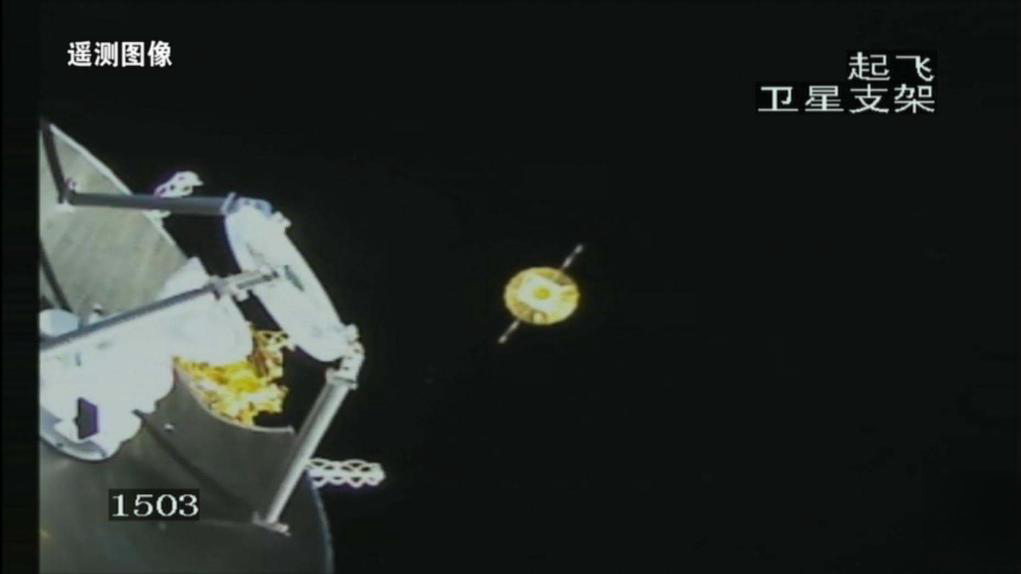Since the establishment of the People's Republic of China, remarkable progress has been achieved in the aerospace sector.
Notable achievements include launching the groundbreaking Dongfanghong-1 satellite, deploying satellites for remote sensing and meteorology in low-Earth orbit, and establishing the BeiDou Navigation Satellite System (BDS) in high-Earth orbit. From developing Long March rockets to advancing the Shenzhou spacecraft, building space stations, and conducting successful lunar and Martian missions, these vital national assets have established a robust foundation for China's goal of building its strength in aerospace.
April 24, 2024, marks the ninth celebration of "China Space Day." In a special report at the Forum of the China Hall of Science and Technology on July 17, 2021, Bao Weimin, vice-president of the CAST, shed light on China's space exploration history and its current emphasis on aerospace advancements in the new era.

Bao Weimin, vice-president of the CAST delivers a report at the Forum of the China Hall of
Science and Technology on July 17, 2021.
Photo credit: WeChat official account of the CAST
In the modern era, advancements in science and technology, particularly in the realm of aerospace equipment such as rockets, satellites, spacecraft, space stations, and probes, have empowered humans to travel to and from space, utilize space, explore space, and promote space governance.
Traveling to and from space requires the use of carrier rockets and other space vehicles to deploy satellites and payloads into Earth's orbit, deep space, or bring them back to the ground as required. A strong capability for space travel broadens the scope of opportunities for aerospace endeavors.
Utilizing space encompasses leveraging satellites and other spacecraft to harness the space environment and resources, delivering communication, navigation, remote sensing, and other services to the public.
Space exploration entails utilizing space stations, probes, and other spacecraft as primary platforms for scientific exploration, unveiling natural phenomena and universal laws.
Space governance involves crafting a legal framework for aerospace, managing space traffic, conducting activities such as space debris removal and near-Earth asteroid defense, and ensuring sustainable space utilization.
History of China in space
China's aerospace development began with the establishment of the Fifth Research Institute under the Ministry of National Defense on Oct 8, 1956, following a proposal by Qian Xuesen. The inauguration of the institute marked the beginning of China's venture into aerospace technology, resulting in notable advancements in carrier rockets, satellites, manned spaceflight, lunar exploration, Mars exploration, and bolstering national defense, economy, technology, and culture. The journey has since paved the way for remarkable achievements in various aerospace fields.
On April 24, 1970, China launched the Dongfanghong-1 satellite, marking its entry into space exploration. On October 15, 2003, Shenzhou-5 was launched, advancing China as the third nation with manned spaceflight capability. On October 24, 2007, Chang'e-1 was launched, initiating China’s deep space exploration.
China's space achievements continued with Long March-5 launched on November 3, 2016, boosting its global rocket carrying capacity. On January 3, 2019, Chang'e-4 landed on the Moon's far side, showcasing advanced technology. By June 23, 2020, China completed its Beidou-3 satellite navigation system.
On December 17, 2020, Chang'e-5 returned Moon samples at cosmic velocity, ranking China third in lunar sample return. Tianhe, the core module of China’s space station launched on April 29, 2021, marking the onset of the Chinese space station's construction. On May 15, 2021, Tianwen-1 successfully landed on Mars, marking China as the third nation to fulfill missions to Mars.
On June 17, 2021, three astronauts entered the Tianhe module, initiating human habitation in the Chinese space station. These milestones, from Dongfanghong-1 to Chang'e-1, have established China as a significant player in aerospace.
China's aerospace advancements
During the 13th Five-Year Plan period, China successfully launched six new-generation carrier rockets, including the Long March-5, which boasts a payload capacity of 25 tons to low-Earth orbit and 14 tons to geostationary transfer orbit (GTO). This achievement demonstrates China's world-class space capabilities, showcasing rapid progress in the Long March rocket series.

This photo taken by a satellite bracket camera of the Long March 8 carrier rocket on March 20, 2024 shows the Queqiao 2 relay satellite (C) successfully separating from the carrier rocket with its solar wing and antenna successfully unfolded.
Photo credit: The China National Space Administration
The Long March-1 in 1970 had a payload capacity of 0.3 tons, while the Long March-5 in 2016 increased this to 25 tons, over 80 times higher. The speed of development has shown a remarkable acceleration, as the first 100 Long March rocket launches spanned 37 years, while the latest 100 launches were achieved in just 3 years.
The use of space technology has extended to communication, navigation, and remote sensing fields, catering to both economic and social demands.
Communication satellites have transitioned from development to commercial use, offering mobile and broadband services through constellation networks.
Navigation satellites, like Beidou, have achieved global coverage with advanced features like new navigation signals and high-performance atomic clocks.
Remote sensing satellites provide high-resolution imaging which supports various industries. In 2020, the total output value of China's satellite industry reached 533.3 billion yuan, with navigation accounting for 403.3 billion yuan.
The Beidou Navigation System monitors millions of vehicles and thousands of maritime facilities, while Fengyun meteorological satellites serve 115 countries and regions.
In manned spaceflight, China has shifted its focus towards space station construction. As of July 2021, China successfully launched 14 spacecraft, two space labs, and one space station module, with 17 astronauts sent into space. The Shenzhou manned spacecraft series has completed 12 missions, including seven manned flights, all of which were successful.
Additionally, the Tianzhou cargo spacecraft completed two missions with top-ranking efficiency, achieving breakthroughs in key technologies such as manned flight, cargo transportation, and propellant refueling.
In terms of lunar and deep space exploration, China has launched 5 lunar probes, reaching significant milestones such as creating the world's first high-resolution full-moon map, achieving a soft landing on the lunar far side with Chang'e-4, and collecting nearly five times more lunar samples than previous missions.
Moreover, the first Mars exploration mission, featuring Tianwen-1, accomplished orbiting, landing, and roving in a single mission. Notably, "Tianwen-1" stands as the largest Mars rover globally, demonstrating innovative landing techniques for a successful touchdown.

This undated file photo shows an illustration of the Tianwen 1 robotic probe entering the Martian orbit.
Photo credit: The China National Space Administration
China's aerospace agenda
China's plan for its aerospace development is structured into three stages, with various milestones set for each stage. By 2025, China aims to achieve objectives such as launching a manned space station and establishing a satellite internet system. By 2035, the country plans to build heavy rockets for significant near-Earth payload delivery and establish a lunar research station. Moreover, China plans for routine space transport missions and exploration ventures beyond Jupiter in the future.
In pursuit of these goals, China's space agenda prioritizes enhancing access to space through the development of high-performance, low-cost launch capabilities. This includes plans to build heavy rockets capable of carrying payloads of up to 140 tons into low-Earth orbit by 2030. Additionally, the agenda includes the introduction of next-generation manned rockets, which are expected to undergo their maiden flights by 2027.
Maximizing space utilization is another crucial focus, with plans to deploy multifunctional satellites and expand lunar orbit capabilities. The development of a comprehensive space-based information network is also emphasized.
Moreover, China's space agenda underscores its commitment to space exploration, including lunar missions, Mars sample return missions, and the search for extraterrestrial life. Efforts to strengthen space governance through legal frameworks and environmental regulations are also highlighted to ensure the safety and sustainability of space activities.
Vision of China's future aerospace
Aerospace technology has emerged as one of the most dynamic sci-tech fields, playing a significant role in shaping human understanding of nature and society. Representing high-tech capabilities, it serves as a hallmark of a country's scientific and comprehensive strength.
As China strides forward in its aerospace endeavors, the advancement of aerospace development necessitates focused attention in several areas.
Firstly, the implementation of major aerospace projects is crucial to enhancing the nation's overall scientific capabilities, thereby supporting national security and defense technological industrial development.
Secondly, accelerating the development of satellite applications industries, fostering emerging space sectors, and bolstering economic growth through high-quality satellite data services are paramount for the aerospace industry's expansion.
Furthermore, emphasizing original innovation, building strategic aerospace technological capabilities, and transitioning from a follower to an innovator in aerospace development are essential steps towards sustained progress.
Additionally, attracting and cultivating top talents to support the continuous high-quality development of China's aerospace industry is imperative for long-term success.
Lastly, upholding the spirit of aerospace endeavors, including traditional values and historical achievements, contributes to the advances in aerospace, harnessing the spirit as a driving force behind the industry's growth.
Source: WeChat official account of the CAST, VOC